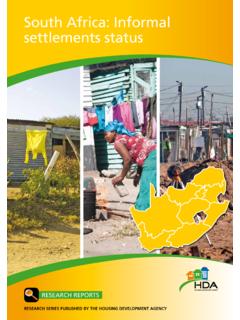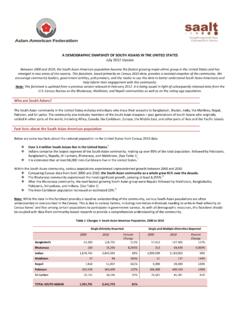Transcription of OECD Economic Surveys SOUTH AFRICA
1 OECD Economic Surveys SOUTH AFRICA March 2013 OVERVIEW This document and any map included herein are without prejudice to the status of or sovereignty over any territory, to the delimitation of international frontiers and boundaries and to the name of any territory, city or area. The statistical data for Israel are supplied by and under the responsibility of the relevant Israeli authorities. The use of such data by the OECD is without prejudice to the status of the Golan Heights, East Jerusalem and Israeli settlements in the West Bank under the terms of international law.
2 OECD 2013 1 Summary OECD 2013 2 MAIN FINDINGS SOUTH AFRICA is advancing, but failing to fully achieve its considerable potential. Per capita incomes are growing, public services are expanding, health indicators are improving, crime rates are falling and demographic trends are favourable. The public finances are in better shape than those of many OECD countries, the financial system is healthy and core inflation is stable and within the central bank s target zone. At the same time, an extremely high proportion of the population is out of work, as has been the case for most of the past three decades.
3 Moreover, income inequality remains extremely high, educational outcomes are poor on average and hugely uneven, and frustration is growing with public service delivery failures and corruption. Output growth is sluggish compared to most other middle-income economies. Environmental challenges such as climate change and water scarcity threaten the sustainability of Economic growth, while high current account deficits represent a point of macroeconomic vulnerability. The macroeconomic policy mix has been insufficiently supportive of growth while allowing large budget deficits to persist.
4 The deficit expanded rapidly in cyclically adjusted terms during the crisis and has been brought down only gradually since. Much of the increase in spending came through large increases in the public sector wage bill, while public investment has fallen as a share of total expenditure. With core inflation remaining well contained, monetary policy has been eased cautiously, but not by enough to prevent an increasing degree of slack in the economy. The rand has swung with international sentiment, and has been overvalued for extended periods.
5 The interaction of weak competition in product markets and dysfunctional labour markets is holding back growth and aggravating unemployment. Most industries are highly concentrated, with network industries dominated by state-owned enterprises, and the weakness of competitive pressures contributes to below-par innovation. Large firms are also able to share the excess returns they make with their employees via collective bargaining, and in many sectors those bargains, including the setting of sectoral minimum wages, are administratively extended to the whole sector, which represents a barrier to entry for small enterprises.
6 The result is a sharply dualised labour market with a well paid formal sector covered by collective bargaining and a secondary market where pay is low and conditions poor. Moreover, millions of SOUTH Africans are excluded from work altogether, contributing to poverty, inequality, crime and ill-health. Strengthening product market competition and improving the functioning of labour market institutions should be high priorities, as discussed in the 2010 Economic survey of SOUTH AFRICA . Education is a critical problem. Skill mismatches represent one aspect of the persistently high unemployment rate, especially for youth: the education system is not producing the skills needed in the labour market.
7 Returns on a high-school certificate, both in terms of finding a job and the earnings premium when employed, are mediocre, while the shortage of skilled workers is reflected in a high premium for university graduates. Shortages of learning materials, teachers, support staff and well-trained principals across most of the school system are among the causes of poor outcomes. If SOUTH AFRICA is to achieve full employment, the quality of basic and vocational education has to be improved. Greater use of market instruments can help deal with long-term environmental challenges at least cost and with limited demands on scarce administrative capacity.
8 The policy framework for addressing green issues, including climate change and water scarcity, is sound, but implementation has so far been slow, in part due to limited administrative capacity. In the electricity and water sectors, there are similar problems: supply is struggling to keep up with demand in a setting in which prices, where they exist, do not cover total costs, let alone reflect environmental externalities. The policy challenge is both to explain the further necessary increases in the relative price of energy and water and bring them about in a manner that minimises adjustment costs and protects the poor.
9 OECD 2013 3 KEY RECOMMENDATIONS Macroeconomic policies Adjust the macroeconomic policy mix, using the full available scope to reduce interest rates to support Economic activity while reducing the structural budget deficit somewhat faster than currently planned. Move towards the introduction of fiscal rules, notably an expenditure rule. Increase the emphasis on the cyclically adjusted balance when setting and explaining fiscal policy. Labour and product markets Curtail the within-sector legal extension of collective bargaining agreements and increase the level of centralisation and co-ordination in collective bargaining to allow for greater influence of outsiders on wages and conditions.
10 Make product market regulation less restrictive, particularly as regards barriers to entrepreneurship. Simplify regulations and ease compliance. Education policy Expand the Accelerated Schools Infrastructure Development Initiative programme to address infrastructure backlogs and improve the delivery of learning materials (textbooks, desks, libraries and computers) with priority to the most deprived schools. Expand the Funza Lushaka bursary programme for teaching studies and allow more immigration of English teachers.















